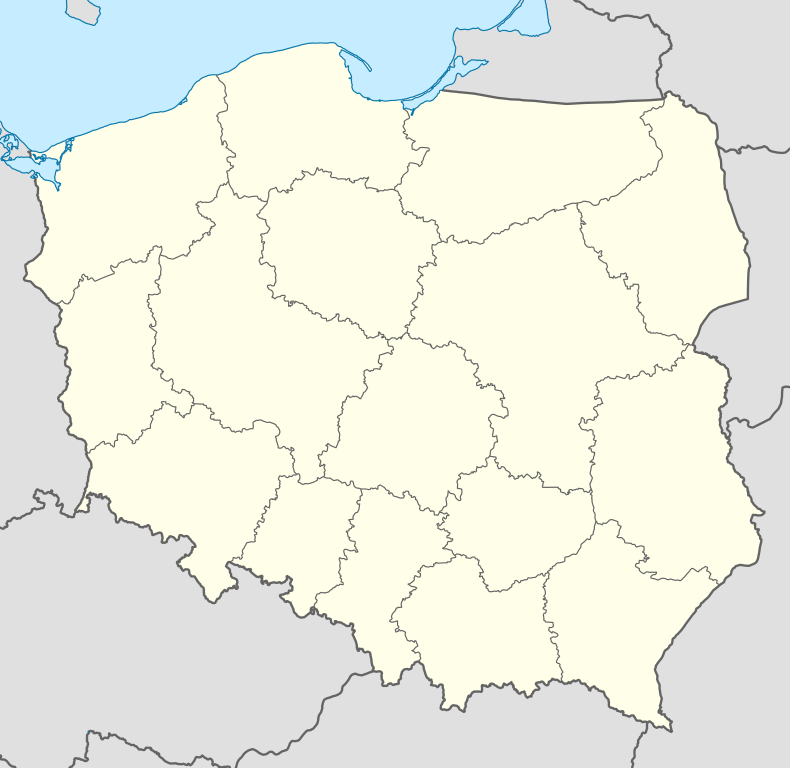Ustroń
| Ustroń | |||
|---|---|---|---|
|
Town Hall | |||
| |||
 Ustroń | |||
| Coordinates: 49°43′9.82″N 18°48′43″E / 49.7193944°N 18.81194°E | |||
| Country |
| ||
| Voivodeship | Silesian | ||
| County | Cieszyn | ||
| Gmina | Ustroń (urban gmina) | ||
| First mentioned | 1305 | ||
| Town rights | 1956 | ||
| Government | |||
| • Mayor | Ireneusz Adam Szarzec | ||
| Area | |||
| • Total | 58.92 km2 (22.75 sq mi) | ||
| Population (2007) | |||
| • Total | 15,414 | ||
| • Density | 260/km2 (680/sq mi) | ||
| Time zone | CET (UTC+1) | ||
| • Summer (DST) | CEST (UTC+2) | ||
| Postal code | 43-450 | ||
| Car plates | SCI | ||
| Website | http://www.ustron.pl | ||
Ustroń [ˈustrɔɲ] (German: Ustron) is a health resort town in Cieszyn Silesia, southern Poland. It is situated in the Silesian Voivodeship (since 1999), having previously been in Bielsko-Biała Voivodeship (1975–1998). It lies in the Silesian Beskids mountain range.
It is the home of the Jan Jarocki Museum, which was founded in April 1986 as Museum of Metallurgy. It is housed in an old building of the former Klemens Steel Works, which was in use between 1772 and 1897.[1] The museum collects technical tools, as well as historical and ethnographic artifacts.
The Równica and Czantoria mountains are nearby and hikable from the town center.
History
The settlement was first mentioned in a Latin document of Diocese of Wrocław called Liber fundationis episcopatus Vratislaviensis from around 1305 as item in Ustrona.[2][3][4] It meant that the village was in the process of location (the size of land to pay a tithe from was not yet precise). The creation of the village was a part of a larger settlement campaign taking place in the late 13th century on the territory of what would later be known as Upper Silesia.
Politically, the village belonged initially to the Duchy of Teschen, formed in 1290 in the process of feudal fragmentation of Poland, and was ruled by a local branch of Piast dynasty. In 1327, the duchy became a fee of Kingdom of Bohemia, which, after 1526, became part of the Habsburg Monarchy.
The village became a seat of a Catholic parish, mentioned in the register of Peter's Pence payment from 1447 among the 50 parishes of Teschen deanery as Wstrowe.[5]
In 1772, the Klemens Steel Works was opened and the village was gradually industrialised. When the steel work was closed in 1897 the market town switched to be more orientated towards a health and spa resort.
After the Revolutions of 1848 in the Austrian Empire, a modern municipal division was introduced in the re-established Austrian Silesia. Ustroń as a municipality was subscribed to the political district of Bielsko and the legal district of Skoczów. In 1856, it gained market town rights. According to the censuses conducted in 1880, 1890, 1900 and 1910 the population of the municipality dropped from 4375 in 1880 to 4275 in 1910, with a majority being native Polish-speakers (91.5%-92.8%), a growing minority speaking German (from 267 or 6.2% in 1880 to 333 or 7.8% in 1910), and dwindling Czech-speaking population (99 or 2.3% in 1880 to 15 or 0.4% in 1910). In terms of religion, the majority were Protestants (57.1% in 1910), followed by Roman Catholics (40.4% in 1910) and Jews (107 or 2.5% in 1910).[6][7] Ustroń was also traditionally inhabited by Cieszyn Vlachs, speaking Cieszyn Silesian dialect.
After World War I, the fall of Austria-Hungary, the Polish–Czechoslovak War and the division of Cieszyn Silesia in 1920, it became a part of Poland. It was then annexed by Nazi Germany at the beginning of World War II. After the war it was restored to Poland.
It gained city rights in 1956. Since the 1960s it saw a large development of new hotels and health centers. A cluster of pyramid-shaped hotels were built in the town. It was also expanded by merger of the surrounding villages: Nierodzim in 1974, Hermanice and Lipowiec in 1975.
Sport
- Kuźnia Ustroń - football club founded in 1922
- TRS Siła Ustroń - volleyball club
Education
- The Alfred Meissner Graduated School of Dental Engineering and the Humanities
International relations
Twin towns — Sister cities
Ustroń is twinned with:
|
People
- Karol Hławiczka, composer and educator
- Theodor Kotschy, Austrian botanist
- Jan Szwarc, politician
Gallery
-
Catholic parish church of St. Klemens
-
Lutheran church of the Apostle James
References
Bibliography
- Szkaradnik, Lidia (December 2008). "Muzeum z huty". Zwrot: 50.
Notes
- ↑ Szkaradnik 2008, 50.
- ↑ Panic, Idzi (2010). Śląsk Cieszyński w średniowieczu (do 1528) [Cieszyn Silesia in Middle Ages (until 1528)] (in Polish). Cieszyn: Starostwo Powiatowe w Cieszynie. p. 297-299. ISBN 978-83-926929-3-5.
- ↑ Schulte, Wilhelm (1889). Codex Diplomaticus Silesiae T.14 Liber Fundationis Episcopatus Vratislaviensis (in German). Breslau.
- ↑ "Liber fundationis episcopatus Vratislaviensis" (in Latin). Retrieved 13 July 2014.
- ↑ "Registrum denarii sancti Petri in archidiaconatu Opoliensi sub anno domini MCCCCXLVII per dominum Nicolaum Wolff decretorum doctorem, archidiaconum Opoliensem, ex commissione reverendi in Christo patris ac domini Conradi episcopi Wratislaviensis, sedis apostolice collectoris, collecti". Zeitschrift des Vereins für Geschichte und Alterthum Schlesiens (in German) (Breslau: H. Markgraf) 27: 361–372. 1893. Retrieved 21 July 2014.
- ↑ Piątkowski, Kazimierz (1918). Stosunki narodowościowe w Księstwie Cieszyńskiem (in Polish). Cieszyn: Macierz Szkolna Księstwa Cieszyńskiego. p. 260, 279.
- ↑ Ludwig Patryn (ed): Die Ergebnisse der Volkszählung vom 31. Dezember 1910 in Schlesien, Troppau 1912.
- ↑ "Újbuda története" [Újbuda - New in History, Twin Towns]. Rafia.hu (in Hungarian). Archived from the original on 2013-05-21. Retrieved 2013-08-11.
External links
| Wikimedia Commons has media related to Ustroń. |
- (Polish)(English)(German) Official web site of Ustroń
- Jewish Community in Ustroń on Virtual Shtetl
| ||||||||||||||||
Coordinates: 49°43′9.82″N 18°48′43″E / 49.7193944°N 18.81194°E






